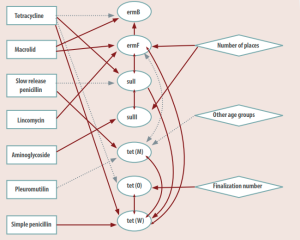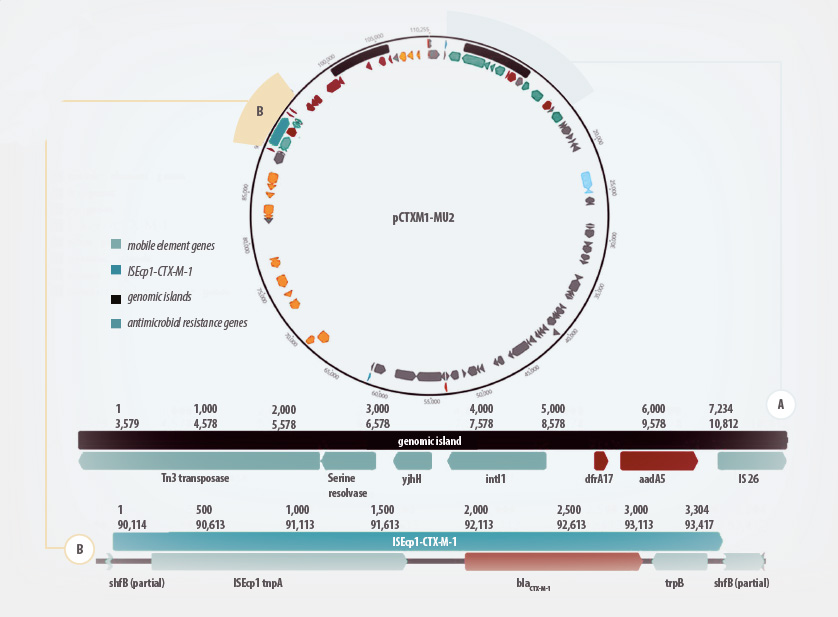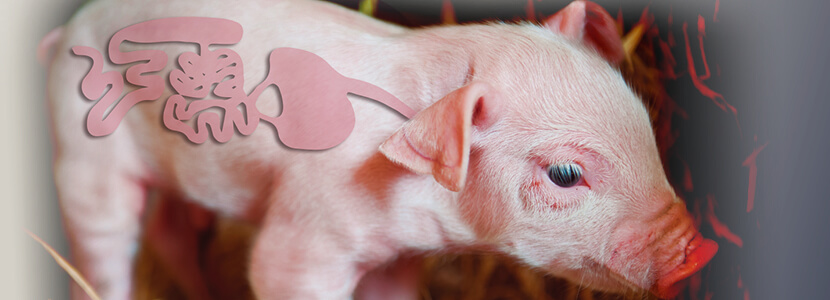Gut health and maintaining optimal structure and function of the gastrointestinal(GI) tract is necessary to achieve sustainable and cost-effective pig production.
The gastrointestinal tract is responsible for regulating physiological homeostasis that provides the pig with the ability to cope with infectious (e.g., enteric pathogens) and non-infectious (e.g., production stressors) challenges.
What does the term ‘gut health’ mean?
‘Gut health’ is a commonly used term that attracts a lot of attention, although a clear definition of this expression seems to be missing. However, generally speaking, according to Pluske et al. 2018:
‘Gut health’ encompasses a number of physiological and functional characteristics including:
➢digestion and absorption of nutrients.
➢ metabolism and energy generation
➢ a stable and appropriate microbiota / microbiome
➢defense mechanisms including barrier function and immune mechanisms of the mucosa
➢ and interactions between these components
Due to the profound changes in (GI) tract structure and function associated with the post-weaning transition, “gut health” in piglets is of great interest for pig production.
![]() The inclusion of antimicrobial compounds, in diets and (or) in water, including antibiotics, kill microbes or inhibit their growth which helps piglets during this period of change. Reducing the impacts of post-weaning growth control.
The inclusion of antimicrobial compounds, in diets and (or) in water, including antibiotics, kill microbes or inhibit their growth which helps piglets during this period of change. Reducing the impacts of post-weaning growth control.
![]() However, the need to implement different feeding strategies and (or) include feed additives (e.g. Pew Charitable Trusts, 2017) due to bans/reductions in the use of certain antimicrobial compounds in some parts of the world have placed greater emphasis on the ‘healthy gut‘ concept.
However, the need to implement different feeding strategies and (or) include feed additives (e.g. Pew Charitable Trusts, 2017) due to bans/reductions in the use of certain antimicrobial compounds in some parts of the world have placed greater emphasis on the ‘healthy gut‘ concept.
A deterioration in the pig’s intestinal health due to the presence of enteric diseases after weaning can be directly related to a decline in the animal’s overall health. Although some direct relationships may be established between the performance and efficiency of the pig and a “healthy” GI tract, sometimes this connection is more subtle and less obvious. Especially in the absence of evident enteric diseases (Pluske et al. , 2018).
![]()
One of the keys to understanding ‘gut health’ is the microbiota, i.e. the ecological community of commensal microorganisms, symbiotics and pathogens that inhabit the gastrointestinal (GI) tract.
It should be noted that, as a synonym, microbiome describes the collective genomes of microorganisms that reside in the GI tract or the microorganisms themselves.
Although the term microbiome technically refers to the population of bacteria, yeasts, fungi, viruses, and protozoa within an ecosystem, the term is often widely used only to refer to bacterial composition.
However, the appropriate terminology when the exploring bacterial population is microbiome or bacterial microbiota.
![]()
The sweeping of the bacterial microbiome in pigs and their complex interactions with the host and external environment (e.g., through diet or through the environment) is a relatively new phenomenon. Which is largely driven by the increasing availability and lower cost of new genomic sequencing technologies.
![]()
➢A growing number of studies suggest that there is a “central” porcine bacterial microbiome, which could be used as a reference for a “healthy” GI tract population.

Research on the GI tract microbiota of pigs has a new and more urgent perspective due to the previously mentioned bans/reductions on antimicrobial compound use for pig production. This highlights the need of maintaining a healthy GI microbiota in key fields of interest with various stressors and infectious diseases. (Brüssow, 2017).

However, some antimicrobial compounds are still allowed in some countries around the world. Which has created a parallel area of interest (and concern) regarding the ability of numerous members of the GI tract microbiota of exhibiting resistance against some antimicrobial compounds. Especially against antibiotics known as (CIAs), critically important antibiotics – which are also used in human medicine.
[register]
What is antimicrobial resistance (AMR) and what does it entail?
Antimicrobial resistance (AMR) has been described as one of the greatest long-term threats to human health (Viens and Littmann, 2015), and, indeed, to animal health and production.
In September 2016, and for the fourth time in its history, the United Nations General Assembly met to discuss a considered global health issue, committing to “comprehensive and coordinated approach to addressing the causes of AMR in multiple sectors, especially in human and animal health and agriculture.”(WHO, 2016).

As described in 2016 by the European Commission, antimicrobial resistance is an evolutionary phenomenon that occurs naturally over time but is accelerated by:
- inappropriate use of antimicrobial medicines in the health, animal, food, agriculture and aquaculture sectors
- lack of access to health services, including diagnostics and laboratory capacity
- and exposure to antimicrobial residues in soil, crops and water
Most AMRs of human medical importance are associated with the use of antimicrobials in the human population. However, resistance in foodborne zoonotic pathogens such as Salmonella spp. and Campylobacter spp., and commensal bacteria from livestock such as Escherichia coli and Enterococcus spp., are under an increasing verification worldwide.
Why does this phenomenon occur?
This is mainly due to the current dependance on the same drugs both for human medicine and for the treatment and control of bacterial diseases in livestock. Especially that of pigs, chicken and cattle.
However, it is also related to:
➢ historical use of some classes of antimicrobials (used in both humans and livestock) at subtherapeutic levels to promote animal growth (the so-called ‘antibiotic growth promoters’ or AGPs)
➢ and the prophylactic (or meta prophylactic) use of antimicrobials in food or water to prevent infections in animal groups.
In addition, the development of multidrug resistance in pathogens such as enterotoxigenic E. coli may result in the unapproved use of critically important antibiotics (CIAs) such as broad-spectrum cephalosporins (e.g., third-generation cephalosporins) (Abraham et al. 2017, 2018).
Most of the resistance to CIAs is encoded in mobile genetic elements such as plasmids and integrative conjugative elements. This can easily cause the transfer of these genese between bacterial species and between humans and animals.
In addition, critically important AMR can be linked to a minor AMR through a process known as co-selection (Mukerji et al 2017).
This co-selection phenomenon is particularly important for livestock industries where the transmission of resistance genes to CIAs can be combined with resistance to first-line antimicrobials. It can even extend itself to standard food additives such as zinc and copper when they are used at supraphysiological levels.
➢Therefore, in certain situations, the standard use of feed additives and first-line therapies can promote the proliferation of CIA-resistant bacteria.(Mukerji et al 2017).
In this context, as several authors have already pointed out (Wegener, 2003; Marshall and Levy 2011, Mukerji et al 2017) pigs constitute a potential reservoir of AMR which can be transferred to pathogenic bacteria in humans through:
• the food chain
• direct contact with pigs
• and (or) the contamination of the environment with pig manure.
As a consequence of such situation, numerous programs and interventions have been implemented around the world to try to address this problem.
However, data and information related to antimicrobial resistance in pigs and their potential contribution to the broader issue may:
- Be Inconsistent
- Vary between countries
- Be difficult to predict
What is known about antimicrobial resistance (AMR) in pigs?
A recent study in Denmark (Birkegård et al., 2017) quantified the relationship between lifetime exposure to antimicrobials and seven AMR genes in Danish pig farms.
- AMR gene levels were quantified by qPCR in faecal samples obtained from 681 batches of slaughter pigs.
- The study showed that the effect of antimicrobial exposure on AMR gene levels was complex and unique to each individual gene.
- Several classes of antimicrobials had positive and negative correlations with the AMR genes.
In this study, only 10-42% of the variation in AMR gene levels could be explained by factors included in the statistical analyses.
In this study, only 10-42% of the variation in AMR gene levels could be explained by factors included in the statistical analyses.
One possible reason for this could be that there are non-antimicrobial risk factors that are known to affect AMR levels, but were not included in this study because no information could be obtained from available registries.
These include transportation, shed temperature, farm management, and metal consumption. In addition, the bacterial composition of the pig gut and feeding strategies also affect the levels of AMR genes because many bacteria intrinsically carry AMR genes.

In conclusion, these associations were found to be more complex than previously described and depended on both the specific AMR genes and the classes of antimicrobials in question. In addition, the results indicate that exposure to antimicrobials is not the only important determinant of AMR gene levels.
Clearly, and according to the literature and what is stated in it, numerous influences in addition to exposure to antimicrobials, contribute to AMR in pigs. Incomplete understanding of selective resistance pressure in livestock, rates of AMR transmission between animals and people, and management practices, which aid or hinder the emergence and persistence of resistance in farms, have made it difficult to assess the risk posed by the use of antimicrobials in livestock and make an accurate prediction (Rosengren et al., 2010).
Broad spectrum cephalosporin research

Fig. 1 Association between antimicrobial exposure and antimicrobial resistance genes. Association map showing the effect of antimicrobial exposure variables
and other factors on levels of antimicrobial resistance genes. The figure is a summary of the effect of the class of antimicrobials and other variables included in the
final regression analysis. The dotted blue line indicates a negative correlation and the continuous red line indicates a positive correlation. Adapted from Birkegård,
A.C., Halasa, T., Græsbøll, K., Clasen, J., Folkesson, A. and Toft, N. (2017). Association between selected antimicrobial resistance genes and antimicrobial exposure
in Danish pig farms. Scientific Reports 7: 9683 (2017) doi:10.1038/
Part of the work being carried out at Murdoch University on AMR includes the use and resistance emergence to broad spectrum cephalosporins in pig production in Australia.
![]()
There is currently a high incidence of AMR in CIAs in bacteria that cause serious human infections worldwide, including, according to WHO (2017)
- broad-spectrum cephalosporins (CS)
- fluoroquinolones (FQ)
- carbapenems
- colistin
Ceftiofur and cefquinome, are third-generation cephalosporins which are registered worldwide primarily for the treatment of respiratory infections in farm animals, including pigs.
»”It has been previously argued that the overuse or misuse of these broad spectrum cephalosporins has led to the emergence of a resistant Enterobacteriaceae reservoir. Which includes E. coli and Salmonella enterica in livestock around the world.

Fig. 2 Genomic map of the pCTXM1-MU2 plasmid carried by broad-spectrum cephalosporin-resistant (ESC) strains of E. coli belonging to multiple E. coli lineages in an Australian pig farm after voluntary elimination of ceftiofur. The positions of gene classes are indicated by color; A – The expanded view of the genomic island consisting of aadA5 and dfrA17 in a Tn3 transposase.b; B – Expanded view of the ISEcp1-CTX-M-1 region Adapted from Abraham, S., Kirkwood, R., Laird, T., Saputra, S., Mitchell, T., Singh, M., Linn, B., Abraham, R.J., Pang, S., Gordon, D.M., Trott, D.J. andO’Dea, M. (2018). Dissemination and persistence of extended-spectrum cephalosporinresistance encoding IncI1-blaCTXM-1 plasmid among Escherichia coli in pigs. The ISME Journal
Since the first report of CS-resistant E. coli and Salmonella serovars in food-producing animals was related to the use of CS in livestock, this has triggered a public health alarm related to the direct transfer of resistant bacteria or the potential plasmid-mediated resistance transfer to humans (Allen and Poppe 2002).
A recent study from Murdoch University (Abraham et al., 2018) investigated the ecology, epidemiology, and characteristics of the CS-resistant E. coli plasmid in healthy pigs over a four-year period (2013-2016) after the withdrawal of this antibiotic.
During this period, high transfer rates of CS-resistant E. coli were observed:

This study demonstrates that CS resistance can persist for an extended period after the removal of direct selection pressure. Resulting in the emergence of CS resistance in both commensal E. coli and atypical enteropathogenic E. coli isolates of potential importance for human and animal health.
Conclusions
“Gut health” is a major goal for the swine research sector. With special interest in conducting a thorough examination of feeding strategies and techniques to establish a GI tract microbiome that is appropriate for optimal pig production and efficiency in the absence of some antimicrobials.
The use of antimicrobials in pig production has evolved from being a tool to improve efficiency and bacterial infections to an increasingly compromised production instrument. The increase in resistance to these compounds, has lead to bans/reductions in their use.
However, some antimicrobials are recognized as a necessary intervention for veterinary care and the welfare of pigs and therefore it is necessary to preserve their appropriate antimicrobial use.
This situation of change in the use of antimicrobial compounds has become even more crucial since the emergence of RESISTANCE to CIAs in livestock systems around the world. Which highlights the requirement for continuous surveillance and genomic characterization of CIA-resistant bacteria to mitigate the spread of AMR in pigs and its potential impact on human health.
In this sense, future research may aim at the potential for overgrowth of resistant bacteria that affect standard microbiota compromising “gut health”.
Similar to the development of dysbiosis after short-term administration of therapeutic antibiotics, resistant microbes can overpopulate the GI tract after certain prophylactic treatments, resulting in decreased “gut health” and production.
Therefore, nutritionists and food manufacturers should be aware of the current rules and regulations on the use of antimicrobials and how this determines the formulation and/or supply of the food. As well as becoming actively involved in projects and conversations in order to confirm the efficacy of nutritional solution. Obtaining a better understanding of the mechanisms that allow different and appropriate measures to improve animal health. and immune status.
In addition, there must be a greater understanding of socio economic factors from the pork producers side since they are the ones that take decisions about these nutritionally optimized foods. Therefore it is also crucial for them to listen closely to the advice issued by their trusted experts.
[/register]














